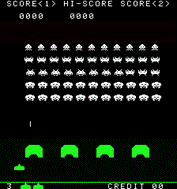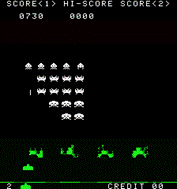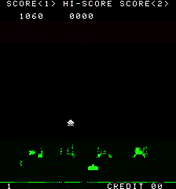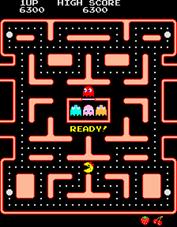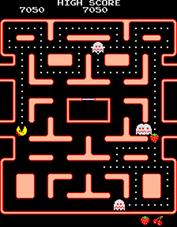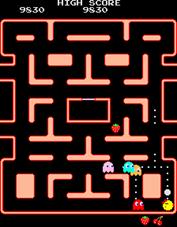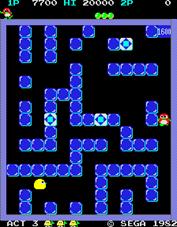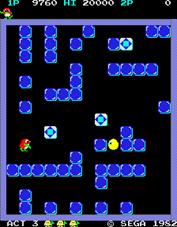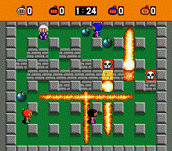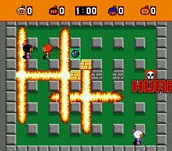Variation over Time-The Transformation of Space in Single-Screen Action Games
Published in Friedrich von Borries, Steffen P. Walz, Ulrich Brinkmann, Matthias Böttger (eds): Space Time Play. Basel: Birkhäuser 2007. (Slight edit, February 2010.) IntroductionThe question is this: How can a video game provide enough variation to keep players interested? The near-universal method for creating variation in a video game is to gradually increase the level of difficulty over time. This ties into the observation that players prefer games with some element of difficulty, and that since players gradually learn while playing, this level of difficulty must therefore change during the playing of the game. Players generally respond very negatively to games they find too easy or too hard, and negatively toward games they perceive as repetitive(1). All games run the risk of exhaustion, of the player reaching a point where he or she experiences the game as not presenting anything new. Difficulty forces players to reconsider their strategies. We can conveniently distinguish between quantitative and qualitative variations in difficulty. For example, in a hypothetical game where the player must collect boxes within a specific time period, the difficulty of the game can be modified in two ways:
A player will then have several ways of improving his or her performance: quantitatively by making decisions faster and turning around corners more quickly, or qualitatively by modifying playing strategies such as finding a shorter route through the playing field. Process over DataMy interest here is in a specific way of providing variation, the qualitative change of difficulty that is created by opening the playing field during a game level. This is a type of design where obstacles are gradually removed and the playing field becomes more open as a result. We can see this design in a number of board games (e.g. backgammon, chess, checkers), and it was a popular design in the non-scrolling action video game, most prominently in the 1980s. But for reasons I will discuss later, this design has become unusual in contemporary video games. Consider the early video game Space Invaders (Taito 1977) as a first example. (Figure 1.)
In Space Invaders, shooting the opponents speeds up the game and changes the play field. Shooting columns of opponents to the side of the field buys the player time by slowing the opponents’ advance towards the bottom of the screen. Shooting rows of opponents at the bottom (generally considered the inferior strategy) also buys the player time. Each level begins with an almost full screen of slow-moving opponents and ends with an almost empty screen of fast-moving opponents. In a fundamental way, this is what makes Space Invaders an interesting game: The player must adapt to a constantly changing playing field, and the player modifies the playing field by shooting, which again lets the player influence what strategies will be needed during the rest of the level (2). From this game, we can for a moment consider a video game poetics that celebrates games with a minimal number of elements working together to create variation and depth (3). In the opinion of game designer Chris Crawford, computers are fundamentally machines for processing data rather than storing it, and video games therefore should focus on processing over storage, on process intensity over data intensity:
In Crawford’s view, then, Space Invaders could constitute a landmark work, perhaps a pinnacle of video game design. The basic economy of the game is a maximal amount of variation from a minimal amount of data. It is worth noting that the speeding up of opponents in Space Invaders is quite "in tune with the machine" in that it is born out of technological necessity: the machine only moves one opponent at a time, so fewer opponents on the screen means that each opponent is updated more frequently and consequently moves faster. Changing SpacesSpace Invaders exemplifies a process-over-storage game design and its corresponding play experience. I will now touch briefly on three additional games similarly characterized by level layouts that change during levels.
Pac-Man (Namco 1979) and Ms. Pac-Man (Figure 2, Midway 1981) are games in which the playing field changes not by way of obstacles being removed, but by the removal of targets that the player seeks out: the dots and power pills. The player must plan ahead so that the later stages of a level do not leave the player completely vulnerable, as it would happen if the player consumes all power pills too soon.
Pengo (Figure 3, Sega 1981) begins with a labyrinthine level layout which the player can modify by destroying its constituent tiles, or which the monsters may destroy in search of the player. Unlike in Pac-Man, the paths of the playing field can therefore change during a level. A special bonus is awarded for aligning three diamonds. Aligning the diamonds is easier when the level is more open, but at this point, the player is also less protected by walls, giving an interesting tradeoff for the player who wants to reach a high score.
Finally, Super Bomberman (Figure 4, Hudson Soft 1993) is quite similar to Pengo in having a labyrinth that gradually becomes more open, only Super Bomberman is generally a multiplayer game. Here, players must blow up obstacles (with the risk of mistakenly blowing themselves up). Super Bomberman is special in that it has two distinct phases, a beginning where players are isolated and cannot reach each other, and an endgame where players can directly attack each other. The opening of the level space leads to meeting other players, and this yields a structured and tellable gameplay centered on personal mistakes, allowing for taunts during the buildup, and preparation for the actual showdown. Data over ProcessGame variation by means of a playing field that changes during each level is the signature of a specific moment in video game history. In Chris Crawford's argument, video games should be like this: possessing the beauty of having the same basic setup and rules, and generating variation using these means only. This type of design was born partially out of necessity: given limited storage space, a changing level layout is an economical way of providing variation to players. Ironically, history has made it straightforward to turn Crawford's argument on its head: the introduction of high-capacity game cartridges and CD-ROMs made game machines into good storage devices. However, it is probably unlikely that this change would persuade Crawford to reverse his position to claim that game design should favor of data storage over data processing. The history of game design is not simply a result of technological developments, but increases in data storage capacity certainly allowed the scrolling game to replace the non-scrolling game: suddenly, new playing experiences came from games that were data-intensive, and the processual economy of the changing level layout became less important. Learning to play any game is a process of creating strategies for playing that game, but changing the level layout forces the player to constantly reconsider his or her strategies. In the history of video games, this way of creating variation was superseded by data storage, by new games with vast expanses for the player to explore. References cited
Games cited
|
